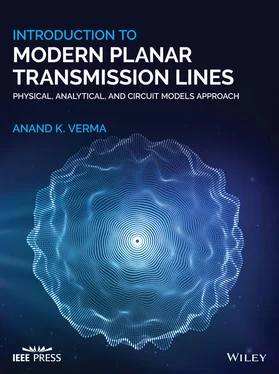2 J.2 Whittaker, E.T.: Oliver Heaviside, In Electromagnetic Theory Vol. 1, Oliver Heaviside, Reprint, Chelsea Publishing Company, New York, 1971.
3 J.3 Verma, A.K.; Nasimuddin: Quasistatic RLCG parameters of lossy microstrip line for CAD application, Microwave Opt. Tech. Lett., Vol. 28, No. 3, pp. 209–212, Feb. 2001
4 J.4 Hasegawa, H.; Furukawa, M.; Yanai, H.: Properties of microstrip line on Si‐SiO2 system, IEEE Trans. Microwave Theory Tech., Vol. MTT‐19, pp. 869–881, 1971.
5 J.5 Kurokawa, K.: Power waves and the scattering matrix, IEEE Trans. Microwave Theory Tech., Vol. 13, No. 2, pp. 607–610, 1965.
6 J.6 Tang, C.C.H.: Delay equalization by tapered cutoff waveguides, IEEE Trans. Microwave Theory Tech., Vol. 12, No. 6, pp. 608–615, Nov. 1964.
7 J.7 Roberts, P.P.; Town, G.E.: Design of microwave filters by inverse scattering, IEEE Trans. Microwave Theory Tech., Vol. 7, pp. 39–743, April 1995.
8 J.8 Burkhart, S.C.; Wilcox R.B.: Arbitrary pulse shape synthesis via nonuniform transmission lines, IEEE Trans. Microwave Theory Tech., Vol. 38, No. 10, pp.1514–1518, Oct. 1990.
9 J.9 Hayden, L.A.; Tripathi, V.K.: Nonuniform coupled microstrip transversal filters for analog signal processing, IEEE Trans. Microwave Theory Tech., Vol. 39, No. 1, pp. 47–53, Jan. 1991.
10 J.10 Young, P.R.; McPherson, D.S.; Chrisostomidis, C.; Elgaid, K.; Thayne, I.G.; Lucyszyn, S.; Robertson I.D.: Accurate non‐uniform transmission line model and its application to the de‐embedding of on‐wafer measurements, IEEE Proc. Microwave Antennas Propag., Vol. 148, No. 1, pp. 153–156, June 2001.
11 J.11 Wohlers, M.R.: Approximate analysis of lossless tapered transmission lines with arbitrary terminations, Proc. IRE, Vol. 52, No. 11, 1365, Dec. 1964.
12 J.12 Khalaj‐Amirhosseini, M.: Analysis of periodic and aperiodic coupled nonuniform transmission lines using the Fourier series expansion, Prog. Electromagn. Res., PIER, Vol. 65, pp. 15–26, 2006.
13 J.13 Ghose, R.N.: Exponential transmission lines as resonators and transformers, IRE Trans. Microwave Theory Tech., Vol. 5, No. 3, pp. 213–217, July 1957.
3 Waves on Transmission Lines – II: ( Network Parameters, Wave Velocities, Loaded Lines )
Introduction
The transmission line sections are used to develop various passive components. These are characterized by several kinds of matrix parameters. This chapter discusses the matrix parameters and their conversion among themselves. It also discusses various kinds of dispersion and wave propagation encountered on transmission lines. The transmission lines could be loaded by the reactive elements and resonating circuits to modify the nature of the wave propagation on the lines. Such loaded lines are important in modern planar microwave technology. Such loaded lines are introduced in this chapter. The primary purpose of this chapter is to review in detail the matrix description of lines and wave propagations on the dispersive transmission line that supports various kinds of wave phenomena.
To review the matrix representations of the two‐port networks using the [Z], [Y], and [ABCD] parameters.
To discuss the basic properties and use of the scattering [S] parameters.
To understand the process of de‐embedding of true [S] parameters of a device.
To understand the process of extraction of the propagation constant from the [S] parameters.
To understand the phase and group velocities in a dispersive medium.
To discuss the circuit modeling of the reactively loaded line supporting both the forward and backward waves.
3.1 Matrix Description of Microwave Network
At low frequency, the circuit is described in terms of several kinds of matrices that relate the port voltages to the port currents. These matrices could be the impedance matrix [Z], admittance matrix [Y], and hybrid matrix [H]. The transmission matrix is defined as the [ABCD] matrix. It is useful in cascading of two or more networks or transmission line sections. At low radio frequency, the voltage and current are measurable parameters. Therefore, the matrix elements of a network and device could be experimentally determined.
Normally, the microwave passive components, circuits, and networks are constructed around the transmission lines supporting the TEM or the quasi ‐TEM mode. Sometimes, the lumped elements are also used. The waveguide sections supporting non‐TEM mode are also used to develop components and circuits. As a matter of fact, the voltage and current can be uniquely defined only for the TEM mode supporting structures. However, for non‐TEM line structures, only the equivalent voltage and current, based on the power equivalence principle, is defined [B.1, B.2].
The abovementioned parameters are discussed in this section, as these are important for the analysis of the line networks and the networks involving both the line sections and lumped circuit elements. The results of the analysis and measurement are also presented using these parameters. The reader can study these parameters in detail from any of the excellent textbooks [B.1, B.3–B.7]. One basic difference could be seen between the lumped elements based low‐frequency circuits and the transmission line sections based on high‐frequency circuits. The low‐frequency circuits are the oscillation type circuits , whereas the high‐frequency microwave circuits are the wave type circuits . In the case of the low‐frequency oscillation type circuits, the port voltage and port current are described by a single voltage or current. In general at any port, for the high‐frequency wave‐type circuits, the port voltage is described by a sum of the incident and reflected voltages, also the port current is a sum of the incident and reflected currents. It is illustrated in the discussions on the evaluation of the parameters.
How to characterize the components, circuits, and network made of the transmission line sections and waveguide sections? At the microwave frequency, port voltage and port current are not the measurable quantities. However, from the analysis point of view, the networks can be characterized by the [Z], [Y], and [ABCD] parameters. But these are not the measurable parameters at microwave frequencies. A different kind of matrix parameter, called the scattering or [S]‐parameters , is used for the practical characterization of the microwave network and the transmission line structures [J.1]. The [S] parameter is a measurable quantity. A Scalar Network Analyzer is used to measure the magnitude |S| of S‐parameter of any microwave circuit and network. For the measurement of the complex [S] parameters, i.e. both the magnitude and phase response of a network, a Vector Network Analyzer (VNA) is used. The Circuit Simulators and the EM‐Simulators (Electromagnetic field simulators) are also used to get the frequency‐dependent [S] parameters response of the microwave circuits.
The [Z] matrix defines the impedance parameter of a two‐port or a multiport network. The matrix elements are evaluated by open circuiting the ports. Therefore, the [Z] parameters or the impedance parameters are also called the open‐circuit parameters . The port voltage (V N) and the port current (I N) are the sums of the reflected and incident voltages and currents, respectively. The port current is an independent variable, whereas the port voltage is the dependent variable. Therefore, the port currents are the excitation sources creating the port voltages as the response . The response voltage is proportional to the excitation current and the proportionality constant has the dimension of impedance.
Читать дальше












